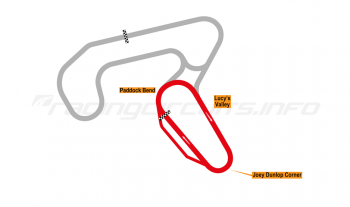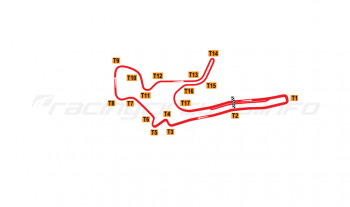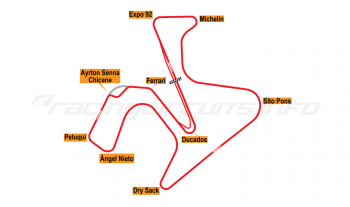Martinsville Speedway
Circuit Overview
Martinsville Speedway holds a unique place in American oval racing, being the only original NASCAR course to remain on today's schedule. Short and flat, like two drag strips joined by hairpin corners, 'the paperclip' provides close and action-packed racing where strategy and luck often win out over brute horsepower.
Because of its small size, tight corners and unique shape Martinsville offers some of the most exciting and close-quarters racing in the sport.
Now owned by NASCAR, Martinsville Speedway conducts three major race event weekends each year. The track annually hosts the NASCAR Cup Series races in the spring and in the fall, the NASCAR Xfinity Series in the fall, the NASCAR Camping World Truck Series in the fall, the NASCAR Whelen Modified Series race in spring, and the ValleyStar Credit Union 300 NASCAR's biggest, richest and most prestigious Late Model Stock Car race.
Circuit History
The track was founded by H. Clay Earles, a local businessman who had made modest profits from several gas stations and a restaurant in Martinsville. Having seen the crowds attracted by car racing at temporary tracks at fairgrounds, he bought 30 acres of land outside the town in 1946 and began planning a permanent facility. His partners in the adventure were two brothers, Jim and Bill France, with Bill promising a field of drivers and advertising in return for a quarter of the profits.
The 0.526 mile track was built by 1947, although at this stage featured a dirt rather than asphalt surface. Earles had initially planned to spend $10,000 but ended up putting in $60,000 to get it completed to his exacting standards. Seating was provided for a modest 750 spectators and to promote the first race, Earles and France proclaimed that it would be dust-free because of the oil and other materials they spread on the track. Evidently the marketing ploy worked, as more than 6,000 paying fans showed up for the race, many dressed in their Sunday best, with another 3,000 able to watch without shelling out for the privilege.
"It turned out to be the dustiest race I've ever seen," Earles recalled in a 1998 interview. "When the race started, it looked like someone had dropped the atomic bomb." Red Byron motored onto victory in that inaugural race, winning a $500 prize for his efforts, despite injuries sustained in World War II meaning he had to use a special stirrup on his left leg and a modified clutch pedal.
The Earles and the Frances made a small profit on the event and Earles soon set about beautifying the facility, adding seating for up to 5,000 and ensuring the ancillary amenities were up to scratch. The dust didn't prove too much of a deterrent to the fans either and, by 1949, France had gone on to found the NASCAR championship with Martinsville was awarded the sixth round of the series. More than 60 years later it remains the only track to have hosted a race in each year of NASCAR competition.
Rising to the fore
As stock car racing's star began to rise, so did Martinsville's. A steady stream of improvements came over the years, with Earles always keen to ensure that customers always went away with positive memories. In 1955, the dust bowl gave way to an asphalt surface for the first time, with two 800-foot straights joined together by short, tight and almost flat turns with just 12 degrees of banking. The compact nature of the track required pit facilities on both straights in order to accommodate a full race field.
An unusual tradition was started in 1964, when Earles began awarding the winners of the main NASCAR evens with grandfather clocks instead of trophies, a nod to Martinsville's famous furniture industry. Richard Petty holds the record for the most clocks won at 12 (he also has three further wins to his name pre-dating this practice), while other victors over the years have included star names such Darrell Waltrip, Jimmie Johnson, Jeff Gordon, Fred Lorenzen, Harry Gant, Mark Martin, Junior Johnson, Lee Petty, Fireball Robert and Joe Weatherly.
Into the 1970s, the rising speed of NASCAR events meant the old asphalt surface was struggling to hold up to the rigours of high-traction slick tyres. In 1976, the course was completely repaved, this time with a concrete surface in each of the turns (quite an innovative concept for the times). Despite the change of surface, the racing remained as before – frenetic and action-packed. Few, if any, winners ever emerged without the battle scars to show for it.
Seating capacity rose ever higher over the years; those initial 750 seats rapidly increased to today's 61,000, enclosing the track along the turns and front stretch. For years, plans to increase capacity by introducing a grandstand along the backstretch were thwarted by a lack of space caused by the proximity of the Norfolk Southern Railway. In 2006, the railway was actually rerouted by 200 feet to create room though, to date, no mention has been made by track management of any new expansion plans.
Changes in ownership
In 1988, Earles handed over the running duties at the track to his grandson, W. Clay Campbell, but the process of continual improvement remained. In 1999 pit road was reconfigured to extend from the entrance of turn 3 to the exit of turn 2, eliminating the need for a separate pit lane on the backstretch, which had always been unpopular with drivers and teams. Modern garages were built in their place, while the infield also boasts state-of-the-art medical and media facilities.
In 2004, the Frances acquired total ownership of the facility through their International Speedway Corporation (now part of NASCAR) in a $200 million sale, with W. Clay Campbell remaining in place as the track's President. The same year, the 28-year-old concrete surface began to break up, with the April event red flagged while repairs were made after a chunk of track broke free and wedged in the nose of Jeff Gordon's car. The track was completely resurfaced later that year, with the two grooves of concrete extended by about 100 feet past the exit point of the turns. SAFER barriers were installed at the same time.
Jump onboard
Circuit info
- Martinsville Speedway, 340 Speedway Road, Ridgeway, VA 24148, United States
- +1 276 956 7200
- Email the circuit
- Official website
Rate This Circuit
Votes: 5200
Plan a visit
Get your race tickets!
Brought to you with: 
We've teamed up with Motorsports Tickets to bring you the best deals for Formula One, MotoGP, Le Mans and more.











